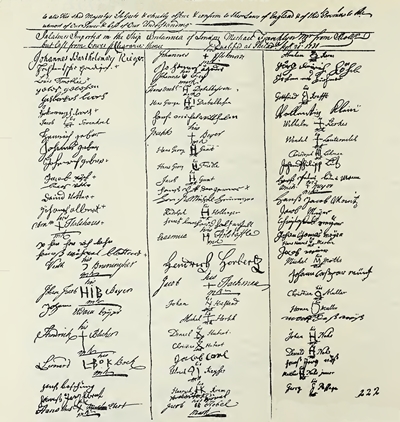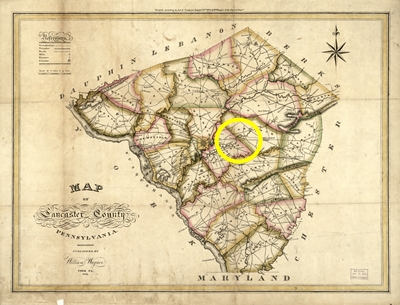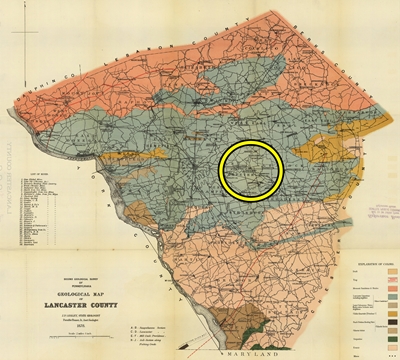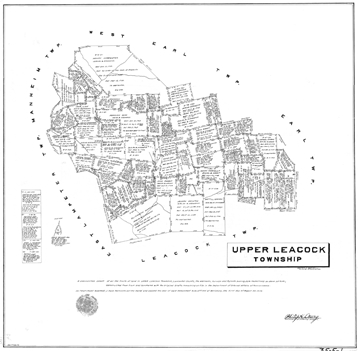| Hans John Bushong IV the Dutchman |















|
|
Hans John Bushong IV
The Dutchman
By Rick Bushong
October, 2019
|
Click to enlarge.
John's Leacock Township land survey done in 1734 by John Taylor. It was returned and patented January 7, 1753.
For survey cover sheet with 1753 patent date, click here.
|
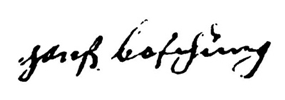 Hans "John" Boschŭng IV
Hans "John" Boschŭng IV | |
Barbara Bushong |
|
1692-1749 |
|
1694-____ |
Married about 1719
Their children
- Mary Magdalena Bushong (Eckman)
- Hans Philip Bushong
- Anna Barbara Bushong (Grimm)
- Christianna Bushong
- John Bushong V
- Jacob Bushong
|
John Bushong IV
|
| Mary Bushong
____-1751 |
Second wife
|
Prologue: Reconciling Family Lore with Fact
Hans Boschung/Bushong, was never named Beauchamp nor was he ever called Jean. Make no mistake, in Hans' time there were several Beauchamp families in North America, including more than one Jean Beauchamp. Of course the Beauchamps were of French descent, and most likely Huguenots too. However none were called Bushong, at least in Pennsylvania. Take for instance, Jean Baptiste Beauchamp,5 who was born in 1702 in Quebec, Canada and died there in 1752.5 This line started in the new world in Canada as fur traders and plied the rivers in canoes down into Michigan.5 But they were never in Pennsylvania. Then as another example there was a John Beauchamp (1652-1740) who was from Hartford County, Connecticut, which is logically where he died. But he never lived in Pennsylvania.6 For those who mistakenly said Bushongs were Beauchamp, these examples as well as others represent a conundrum. Since none of them changed their name, why would Hans have changed his name in the first place? In the past, aside from anglicizing, the incidence of immigrant name change has been commonly overstated. Through personal research as well as studies of Ellis Island immigrants it has been shown to be most often myth.7; 8
It all began in 1844 when Professor I. Daniel Rupp, in his book, History of Lancaster County: to which is prefixed a brief sketch of the early history of Pennsylvania,4 mistakenly called Hans a French Huguenot. Then apparently Mr Rupp compounded his mistake in a subsequent book, when he incredibly pronounced that the surname Bushong originated with Beauchamp. He did this in contradiction of the name Hans gave when he immigrated, which is same name listed in Mr Rupp's book. It was Boschung, an old Swiss surname.9 Below, Mr. Rupp, being cited for much of the page, seems to have been the source....
 "The name of the Bushong family is said to have once been Beauchamp."
"The name of the Bushong family is said to have once been Beauchamp."
Phebe Gibbons, Pennsylvania Dutch, Published 1872 (page 99).10
This appeared in April 1872 in Phebe Gibbons' "Pennsylvania Dutch".10 Mr. Rupp's specific reference has yet to be located, but perhaps it will come to light. It is possible the reference can be found in the first edition of the Thirty Thousand Names book. It was originally published in 1856 in serial fashion. The May-June 1856 issue began with immigrant arrivals in 1732. The prior issue, March-April, 1856 might have had Hans Boschung's 1731 arrival listed and possibly Mr. Rupp's Beauchamp assertion. However, Mrs. Gibbons' book offered no proof and it seems she was using Mr. Rupp as a source. This is ironic since the Gibbons and Bushong families knew each other, and there were dozens living in Upper Leacock as listed in the 1870 Census. In fact, a Bushong lived just one farm away from Mrs. Gibbons in 1870.11
From that point, the mythology of Hans Boschung was embellished and repeated. It wasn't only family genealogists who spread the misinformation, but so did often prestigious historians and authors. Later in the 1920s, family researcher Mary Feller Wicks added "Barbara Foltz de Hageneau",12 to the lore and son Jacob was renamed Jacob Pierre. There was no evidence for their assertions. The Bushong family copied and repeated it. After all, it was a quirky bit of history, having a French Huguenot family surrounded by Dutchmen. Considering that France was a perennial enemy of England and Germany, it would make the Bushongs very different from their new countrymen, especially their German neighbors, even if they shared religions. However the reality was they were Dutch all along, though this makes the Bushongs not so unusual from their neighbors. Regardless, the Pennsylvania Dutch are indeed, unique to Colonial America's history and the Bushongs were were part of them. In the end Mr. Rupp can be refuted, with these facts.
- He signed his name: Hans Boschung, not Jean Beauchamp.
- His writing was German Kurrent script, matching his brother, Johann Nicholas'.
- His 1734 Land Patent and Survey lists him as Hans not Jean.
- He was proclaimed German (and Protestant) by his 1739 naturalization.
- His nephews and nieces (connected by DNA analysis), were born in Germany, as was likely his brother, Nicholas.
- His son Hans and four grandsons had German names: Johannes, Hans, Andreas, and Wilhelm.
- In his will, he uses the German word broders (bruder) instead of the French frères.
- John was German and named Boschung.
|
Perhaps a good question would be: Who was the Dutch John Bushong? The Pennsylvania Dutchman, Hans Boschung, began his life's journey, about 1692, probably in Germany near what is now Minfeld, Rhineland-Palatinate, Germany. Of this, it can not be said for certain, since church records are still being searched. This is also true of his date of birth which is derived from his stated age when he arrived in Pennsylvania.1; 2 His brother Johann Nicholas and two other siblings were born in Germany, including sister, Anna Elisabeth Boschung, on February 2, 1682.22
As mentioned, Hans is related to Johann Nicholas, of the 1732 voyage. Their relationship, proven through DNA, was fully explained in an article first published in 2012 and subsequently in an updated article in 2015, titled: DNA Connects Virtually All Bushongs,17 But a brief explanation is, in 2012 when DNA samples from nine Bushongs, five from Hans' and four from Nicholas' lines were analyzed, their DNA matched.17 This undeniably united their two branches in the Bushong Tree. Since then more have been tested and as expected, they matched, which reinforced the findings. DNA analysis has shown that the two have greater than a 94% chance of being brothers, with a small chance they were cousins or one was a nephew.17 Nevertheless since 2012, it has come to be accepted that Hans and Nicholas are brothers and hence both sons of the German-Swiss, Hans John Boschung III.21; 22; 23 Their father was born in 1661 in Oberwil, Simmental, Bern, Switzerland,23 but left as a young man and moved to Germany24 where it was he probably met and married their mother, Anna Maria Boschung.21; 22; 23 Our Hans was married in approximately 1719, to Barbara, whose maiden name is unknown, (and not Foltz), as discussed above. She was born probably in Germany about 1694 and before coming to Pennsylvania, they had four children, most likely born in Germany too.21
|
Oath of Allegiance for the Britannia, signed September 21, 1731, in Philadelphia. Hans is the left column, 3rd from the bottom. |
|
 From Professor Rupp's 30,000 Names book.1 Inexplicably, oldest daughter
From Professor Rupp's 30,000 Names book.1 Inexplicably, oldest daughter
Magdalena is left out of Mr Rupp's book, but she is in Mr. Strassburger's book.2
Click for full page.
We can approximate their dates of birth from the ages listed in Pennsylvania German Pioneers:2 Mary Magdalena Bushong, born in 1720, Hans Philip Bushong, born 1722, Anna Barbara Bushong, born 1725, and Christianna Bushong born 1728.1 In the spring of 1731, Hans and his family would have left Germany and found their way to Rotterdam where they located a boat to America. They booked passage on the British Ship Britannia, commanded by Michael Franklyn. The Britannia departed sometime towards the end of June or beginning of July, and as was required, first sailed to England, where at Cowes, the passengers obtained permission to immigrate to the British Territory, Pennsylvania.1
Nothing is known about the family's Transatlantic crossing after they left Cowes, which usually took eight or nine weeks. Suffice to say it was faster and easier than his brother's voyage on the Pink "John and William,"25 the following year. On that ship, 44 immigrants died, and the passengers mutinied.1; 23 Eventually, in the third week of September, the Britannia sailed into Philadelphia Harbor.view source; full page That Friday, September 21, 1731, Hans signed the Oath of Allegiance at the Philadelphia Town Hall, as witnessed by Rob Charles, Clerk of Philadelphia County.1; 26view source; full page
|
The Boschung family had money to pay for their voyage, which is determined by Hans' land ownership in only two years, as discussed later. This precludes his indenture, since the minimum indenture times were two years.27 Also being indentured meant virtually no pay with which to buy land, so the Boschung family clearly was able to pay for passage. With that, the family was free to travel to the newly formed Lancaster County, where they would join the growing Dutch population. In Lancaster County, where he and Barbara would spend the rest of their lives, Hans became known as John Bushong.
Bushongs and the Pennsylvania Dutch
Their Religions
Discussed in his father's chapter,30 the original undivided land grant, envisioned as four hundred acres, would have adjoined Jacob Heller's.30 Mr. Heller is remembered for his land donation to the area's first church,31 which was appropriately called Heller's Church. In early records, the church was also known as Hill Church, because of the mild rise it is built on.32 A corner stone placed by the Dutch congregation in the existing church attests, the church and congregation were founded in 1722. However, there are indications their first log cabin meeting house was erected as early as 1719. The current church actually occupies the same location as that log church did.31
Heller's church was the first Reformed Church in Lancaster County, and some believe it could be the first in America.33 The original church had only a dirt floor and seating was provided by rough hewn logs placed in rows on the ground, with a flat side turned up. Located adjacent to the church still exists the cemetery dating back to 1729. In it there are numerous tombstones, of which many are carved fully in German. This is the case for Hans Philip Bushong's wife, Anna Eva (Hergard) Bushong who died in 1778. She is one of over sixty Bushongs buried there. Today the church still holds services at this location. Its modern address is 2555
Horseshoe Road, Lancaster, Pennsylvania. It is known as "Salem Evangelical Reformed Church, Hellers." or shortened: "Salem Hellers Reformed Church"32
|
|
The original Hellers log church built on the land Jacob Heller donated.
More than a few Bushong's attended this church
and many are buried next to it.
|
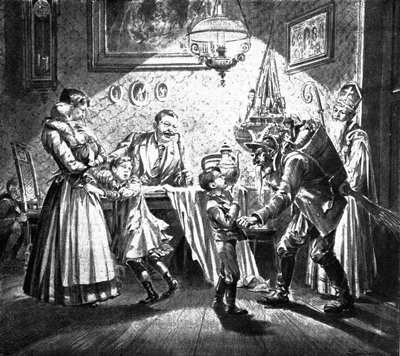
St. Nicholas and the Krampus visit at Christmas.
|
|
Their Customs and Cuisine
To the "New World," the Dutch colonists brought with them their appreciation for the pleasures of life and hospitality, which are in stark contrast to the more austere Puritans before them. Some of the customs and habits handed down by the Dutch became national traditions while others simply added a certain sociability to daily life. For instance in Dutch country, the holidays were times for great feasting and much merrymaking. Dutch customs such as visiting neighbors to share a drink on New Year's Day, were widely practiced and are still common today. As another example, the Christmas tree was introduced by the Dutch. Undoubtedly their greatest contribution to
Christmas was Saint Nicholas,34 whose visitations were joyous occasions, and they still are. On the other hand, one Dutch Christmas tradition thankfully fell out of favor, and that was
the "Krampus" a frightful and horned associate who traveled with Saint Nicholas. The Krampus was there to punish bad children which he was frequently known to do.10; 35
|
American cuisine is indebted to the Dutch. Though they are commonplace now, America's fare would be sorely lacking without them. For example, the Germans were eating hamburger years before 1900, when Louis Lassen first put it between two slices of bread.36 It is of course named after the city of Hamburg, in Germany.34 No less important is the frankfurter, now the American hotdog.34 A host of other foods, such as sauerkraut, bratwurst, liverwurst, scrapple, pork rolls, and apple butter, are all mainstays of American food, thanks to the Dutch. Or perhaps a sweet food, such as the gingerbread house. The Germans were the first to make edible gingerbread houses and miniature scenes from an ancient Chinese cookie recipe.37
Land was the force that drew John and the other Dutch to America. In Europe, land was scarce, and since their religious beliefs differed with the ruling
Catholics, they faced many more barriers to land ownership. In America, owning land would allow the immigrants the stability to develop their properties, and in doing so, build prosperous farms. To buy land is probably the reason John's father came in 1719, but in 1731, John
would have been coming, not to buy land, but to receive it as his inheritance. This since in all likelihood, John's property had been his father's (discussed in a previous chapter).30 His father died prior to 1734 and the property was split between John and his
brother, Nicholas. When Nicholas died shortly after his arrival, his underage son, Andrew, received the
property by right of inheritance. It is Andrew's underage land ownership which establishes that
his land was inherited. Then with John owning land next to his nephew in the beginning of 1734,
the only explanation is that he inherited it too.
Their acreage was in an area once known as the Mill Creek Settlement and it began to be settled about 1719,4 the year John's father immigrated.1 In the fall of 1731, when John arrived in Lancaster County, it was still a young county, having been split off from Chester in 1729. It was also still wild country, with miles of forests and numerous tribes of American Indian. Traveling over sixty miles from Philadelphia to the Lancaster County farm was an adventure in itself, since the trail consisted of only a patchwork of trails and fords across streams.
|
|
An 1821 map of Lancaster County, Pennsylvania. East of Lancaster Town, on the border of (East) Lampeter and (Upper) Leacock, (circled) is the area where later survey maps indicate, the original plantation of Hans John Bushong III could have been.
Click for LARGE unmarked map. Compliments of Library of Congress.
|
Click for large zoom able map. Pops-up
In an 1878 Geological Map, the blue area represents
"Lancaster Limestone" soil. Hans' property is about
two and a half miles north of Bird in Hand.
|
|
During the American Colonial immigrations, there are three acknowledged peak periods of Mennonite arrivals. The Mennonites were predominantly from Switzerland, but some lived for a time in Germany, as did John's father. However, it was the second period, between 1710 and 1727, when Mennonites, along with Swiss of other sects, became interested in west Chester County. The area consisted of very gently rolling land and extended west all the way to the Susquehanna River. John's land, called a plantation in his will, was more or less in the heart of Dutch country in the Leacock Township. It would not be until 1843, that it became Upper Leacock Township.
John and his fellow Dutch had homed in on Pennsylvania's richest soil. Made up of decomposed limestone, it had some of the best growing conditions in the northern half of the known new world. Later becoming known as the Lancaster Plain, it is a belt consisting of limestone soil, encompassing roughly two-thirds of the county. About 20 miles at the widest, it runs close to forty miles from east to west to the Susquehanna River,38 the boundary with the surrounding American Indian Nations. Of the area, it was said:
"Wherever there was limestone or black walnut trees, there you would soon find some Germans either farming, or setting up a home prior to turning the soil, for they liked limestone."39 |
Accordingly there are numerous references in survey maps to not only Black Walnut trees, but other desirable hardwood trees such as the Black Oak and White Oak trees. In fact, the Bushong property survey mentions three Black Oak trees, as boundaries. The Lancaster Plain has soil remarkably similar to that found in Switzerland. Once discovered, the newly arriving Dutch immigrants quickly bought up almost all of the land, while moving ever deeper into the county.
|
They were of course buying rights for their land from the Pennsylvania Company, which meant either William Penn, until his 1718 death, or his sons and agents. For an agreed upon price, they were given a Warranty Deed, called simply a warrant. John's warrant, issued February 28, 1734, was signed by John Penn,40 William Penn's oldest son by his second wife. Notably, John's warrant was issued with his German first name, "Hans."
Jacob Heller's property, previously mentioned, was close to John's property, and there are other notable neighbors or landowners. One whose land adjoined John's was John Estaugh, of New Jersey (1676-1742). Mr. Estaugh had over all, 7282 acres (with allowances). His land, in the fork of the Conestoga and Mill Creek was due west of John's. He was also was a representative and agent for the Penn family.41 For the Pennsylvania Company, he commissioned the surveying for most of the area by well known surveyor, Isaac Taylor (1659-1728).42 Beginning in 1701, Mr. Taylor became the proprietaries, or in other words, the Penn's Chester County Surveyor.43 It was his son, John Taylor (1697-1756), who on Saturday, October 16, 1734, completed surveying John's property, eight months after the warrant was issued.44
Mr. Estaugh was a minister for the Society of Friends, commonly called Quakers. In 1702 he married Elizabeth of the Haddon family for which Haddonfield, New Jersey, is named.45 The Haddons were also involved with the Pennsylvania Company. Perhaps Elizabeth and John are most notable for their love story and marriage, immortalized by Henry Wadsworth Longfellow in the poem, Tales of a Wayside Inn, published in 1863.46 John Estaugh died in Tortola in 1742, having voyaged there as a guest minister for a settlement of Quakers.47
|
|
John Estaugh's land survey, completed and drawn by Isaac Taylor, May 16, 1717. John Bushong's land was due east, adjoining where it is circled.
|
|
A 1716 survey of Elizabeth Whartenby's (Wartnaby) land south of Hans' property. Notice in 1716 Han's future property is still vacant.
|
|
To the south of John Bushong's farm the land was owned by Elizabeth Duckworth Whartenby (Whartnbey/Whartnaby/Wartenby), (___-1734), who had 1020 acres, from a 1715 warrant. Elizabeth's husband, Edward Whartenby died apparently en route to America or shortly after arriving.48 She arrived in Pennsylvania in about 1713, which is believed to be her first voyage to America.49 Elizabeth was a Quaker minister too, and as part of her missionary work voyaged to many places including Barbados in 1718,50 and Dublin, Ireland in 1727.51
Elizabeth Whartenby died in 1734 and was buried in Philadelphia, Pennsylvania.52
The land that John's and Nicholas' father, John Bushong, III, had purchased is roughly in the heart of the Lancaster Plain. Originally acquired about 1719, it attests to the rate the area was "filling up." Within the next thirty years, most of the county would be sold off, necessitating the Treaty of 1754. This treaty with the American Indians of the Six Nations was instituted to purchase lands to the west of the Susquehanna.53 The Pennsylvania Company paid four hundred pounds (lawful money of New York), and acquired hundreds of additional miles of Pennsylvanian territory.53
|
The Bushong farm, had some of the finest agricultural land east of the
Mississippi River.54 How many acres did John really have? The February, 1734 warrant stated 200 acres,55 but John Taylor only surveyed 137 acres (corrected to 134.5). We can only assume that in the eight months between the warrantee's issue and Mr. Taylor's October survey, 65 plus acres were sold or given away. The land which adjoins John's to the north, looks like it could provide an answer. It was owned by a Jacob (Jaob) Stretch. Since nephew Andrew is listed with adjoining property in 1734, and he is gone by 1737 when Mr. Stretch received his warrant, then it would appear that Andrew had received the extra 65 acres. This adds up since the inheritance for John and his brother Nicholas would have been 200 acres each. With Mr. Stretch's adjoining property containing 265 acres, clearly the 65 acres in question went to Andrew. It is not known why John transferred the property to Andrew, but we can speculate it was to compensate for a difference in value. Possibly John, having arrived a year before Nicholas and Andrew, wanted to keep his father's house and a cleared or improved portion of the farm. He could have easily paid the difference with land.
 Though his name is misspelled, the date matches the warrantee's date.
Though his name is misspelled, the date matches the warrantee's date.
Another mistake: the book calls the warrantee date the survey date,
not only
on John's, but on at least five other properties that were checked.55
Click for full page.
In order to visualize their lives, these are some first hand observations of Colonial Dutch from Dr. Benjamin Rush (1746-1813). Dr Rush, a signer of the Declaration of Independence, wrote an essay in in 1789, Lectures on the Mind, 56 that richly describes Dutch immigrants' methods for building their homes and farms in Colonial America.
In clearing new land they do not simply girdle or belt the trees, and leave them to perish in the ground, as is the custom of their English or Irish neighbors; they generally cut them down and burn them. Underbrush and bushes they pull out by the roots. The advantage is that the land is fit for cultivation the second year....
...In settling a tract of land they always provide large and suitable accommodations for their horses and cattle, before they lay out much money in building a house for themselves. The first house is small and built of logs. It generally lasts through the lifetime of the first settler and hence, they have a saying, that a son should always begin his improvements, where his father left off.56 |
|
|
Upper Leacock Lancaster County, Pennsylvania, connected map. Click to enlarge - Hans' land is lower left side.
|
It cannot be said how much land could have been cleared by his father prior to 1734, but he would have been working on it for over a decade. Either way, John and his father likely used methods similar to what Dr. Rush describes. Did John inherit his father's log house, and how large was it? As Dr. Rush relates, John would have begun where his father left off. As far as can be told, he was to spend the rest of his life in that Leacock Township house. However, within a year of coming to Pennsylvania, John and Barbara (probably), had a son. Thought to be born on August 30, 1732, he was named John, and he has the distinction of being the first Bushong born in America.21 Naming him John, which is of course, the English translation of Hans, he continued the traditional name of his father, his grandfather, and their fathers, making him the fifth of his line with that name. Later that same year, probably towards the end of October or beginning of November, the limitations of their home must have been strained with the arrival of Nicholas, his wife Magdalena and their four children .1 They came in the middle of the 1732-1733 Influenza Pandemic.57 Nicholas and Magdalena had apparently been exposed to the epidemic, either in Philadelphia or enroute to Lancaster County and died shortly after getting to John's house.57
Still life went on and some three years later, in 1735, their last known child Jacob was born. The seasons passed, with their usual mild winters, at least compared with the Swiss fatherland. Then the summers provided bountiful crops. Yet with the warm weather, a part of their lives were the insects, which would eat the crops as well as bite them and their animals. And John would have had many animals on his farm. In his will he mentioned his "catties", which is surely a mistake in the transcription for "cattles". They probably consisted of oxen and dairy cows. Most farms in Lancaster had "cattles" and in addition to their crops, became highly productive and turned a profit for the farmers who worked hard. John's farm was obviously successful and he would have had extra produce to sell. From time to time, he would have traveled to the various mills in the area. In the colonial period, mills were central hubs for refining wheat, other grains and goods. They also served as a central meeting place to sell and trade goods which John would have done. On May 19, 1739, John and several hundred other Dutch were naturalized as citizens, by Pennsylvania's Lieutenant Governor, George Thomas.16 By 1743, John had saved his money and wanted to buy more property.58 It was March 10, 1743 when he bought six acres of land in the Strasburg Township, also in Lancaster County, from a Benjamin Whitmore (Junior) and his wife Mary. The town of Strasburg is a just over five miles away from the town of Bird in Hand, which was a couple of miles from the Bushong farm, so the new property was so perhaps seven miles in all from the Bushong farm.
John's Estate and Second Wife
(Transcription with original grammatical errors)
I John Bushong making by my Life Time and good memory my Last Will and Testament as
follows First It is my Will that all my Plantation where I now twell in together with all the
catties and every thing of moveables and all the winder grains upon my Littel Plantation shall
have my wife in her Power as long as she remains a widow
But in case she my wife marry again then it shall by acknowledge of a magestreed allowed to
her all nesessarries that she is wanten for her life Time and after her death and after the debds
is paid all my children shall have equally shears one as much as the others but my eldest son
Phillip shall have my Little Plantation for the sum of three hundred and ninety Pound [s] and
they shall non of his Broders or Sisters ask any thing of him in time of six years but after the six
years is past he shall pay yearly the sum of fifteen Pounds Dill the said sum of three hundred
and ninty Pounds is paid
Item it is my will that my wife shall find the Bread for my son Phillip for one year together
with as much Grains as he is wanton to sow his Plantation and in case of he marrays and
should die in a years time after then his wife without any Heirs of his Body then his wife shall
have of his estate the sum of seventy Pounds and is my will that my son in Law Philip Grime
shall have allowance to live in my haus and eat of my Bread the time of two years In witness
whereof I have hereunto set my hand by these Presents Date June [number indecipherable]
1749.[June 1, 1749] 221 [proved 18 July 1749]
J. John Bushong, His X mark
Witness:
Frederick Hergerd
John Ekman, His X mark
Andrew Bushung, His X mark
|
 The Index to Volume 24 Abstracts of Lancaster
The Index to Volume 24 Abstracts of Lancaster
County, Pennsylvania Wills, 1721-1880, compiled 1896.
|
|
Some six years after buying the Strasburg land, John, now 57 years old or close to it, recognized his life was coming to an end when on June 5, 1749, he made out his will. It was witnessed by son-in-law, John Eckman, nephew, Andrew Bushong, and Frederick Hergard, who is thought to be father of Anna Eva, wife of Philip. The precise date of John Bushong's death is not known, though it was probably the month he made the will, June, 1749. The will was probated the following month on July 18th.
Where John was buried has been lost from memory. He is not in the Salem Hellers Cemetery, like many Bushongs who followed. If he is, it would be in an unmarked grave, which seems unlikely since he was a man of means and the family could afford a marker. More likely he was buried on his farm, in an existing family plot, now lost. Perhaps he is buried with his brother Nicholas, his father, and as will be seen, Barbara.
At the time of his death, John was still married and a wife is mentioned in the will. Unfortunately she was not named. So was it Barbara who immigrated in 1731 or had she died and John remarried? Some Bushong genealogists say his second wife was a Mary. The source for this has been conjectured to be John's will, since the words, "marry" and "marrays" are used. But when the will, which was written in English, is read from an accurate transcription, it provides the context and it is not a name. However, there is a Mary listed in the 1749 abstracts.59 This is verified by the Pennsylvania Index for the Wills Abstracts, created in 1898, which lists a Mary. Though the actual abstract of the will has yet to be seen, it nevertheless lists Mary Bushong. She is not Mary Magdalena Bushong, John's daughter, who married in 1738, years earlier, and would have been called Mary Eckman. That leaves the logical conclusion that Barbara had died and John's second wife was Mary. Then Mary would have died after 1749 and before the March 1751 Orphan's Court. Further research could add credence to this, and perhaps when Volume 24 of Lancaster Will Abstracts 1721-1880, is seen, it can be verified.
|
The 1751 Orphan's Court establishes John's wife's death prior to March 5, 1751, and this triggered eldest son Philip's eligibility for the full inheritance of John's farm. It also necessitated John's two minor sons to choose guardians, and though it cannot be said how, in the hearing, John's property was reduced to 100 acres. Philip eventually inherited 135.5 acres in Upper Leacock, so possibly he had possession of some of it?
"Phillip Bushong, eldest son
of John Bushong, proposes to hold the Tract of 100 acres his father dyed
seized of and to pay the shares of the youngest children. John Bushong, one of the sons, chuses John Swope as his guardian. Jacob, another son, chuses
Theophilus Hartman as his guardian."
Orphan's Court, Lancaster PA, 5 March 1750/51
It took over nine years, to pay off his brothers and sisters for the family farm, required by the will, but by January 4, 1760 Philip secured the land patent.60 It was to take until 1764 to pay his siblings for their portion of John's six acres of Strasburg property,61 and it appears to have settled in 1772 (recorded 1773).
So when John's wife, whether Mary or Barbara died, probably in February 1751 it was most likely at the Bushong family home in (Upper) Leacock. She was probably buried next to John, in the family plot, along with a host of early Bushong immigrants. But unanswered questions remain. When did Barbara die? There was death all around in 1732, when brother, Nicholas and his wife, Magdalena and family arrived in the middle of the 1732-1733 Influenza Pandemic.57 This was a very dangerous strain of influenza and in America it swept not just Lancaster County, but Pennsylvania and eventually most of the New World.62; 63; 64 Could Barbara have died in the epidemic? We do not know. Then again, did she die prior to son Jacob's birth in 1735? If that were true, then Mary could be Jacob's mother. Perhaps in the future we may find more answers.
|
|
East Lampeter, Lancaster County, Pennsylvania, connected map. Click for large unmarked map.
|

Satellite composite of John's farm land.
Arrow points to the 2nd marker (post) on the west side of John's survey. Notice how close the maps match for the Conestoga Creek (to the left) and Hellers Church (with red mark) are to Jacob Heller's original land.
Click for larger - Pops-up
|
|
Where was John's farm? Was it in the township of East Lampeter or was it in (Upper) Leacock? Beginning with the second question, the confusion is seen on the connected plot maps for East Lampeter and also for Upper Leacock,60; 65 both of which show the Bushong farm in their townships. The 1764 indenture (and likely others) that secured Philip's inherited six acre property in Strasburg stated both his father and Philip were from East Lampeter. Yet the property survey in 1734 said it was Leacock which later became Upper Leacock. So, trusting Mr. Taylor, the county surveyor, it appears that the farm was actually in (Upper) Leacock. Perhaps the Bushong family frequented East Lampeter, which could have been either closer or easier to travel to and eventually they became associated with it. Another possibility is the community of Bird in Hand, established in 1734, just a couple of miles away from the Bushong farm. Interestingly it lies in both Upper Leacock and East Lampeter townships, and this could have caused the confusion.66 Nevertheless, the family farm was officially listed in the Leacock Township until 1843, and afterwards in Upper Leacock Township. Still, the farm's location being commonly called East Lampeter, seems a small mistake, considering all the other mistakes made about this family.
But that does not answer: Where was that plantation where so many Bushongs spent their lives and where
John, his wives, a brother, a father, and we know not which other Bushongs are buried? Aside from the plot map, there is mention of the farm being near Heller's Church and close to Mill Creek. Taking these into account, we can approximate the area where the Bushong farm was. However through the use of satellite imagery and the connected plot map, which can be overlayed, it is possible to get closer. Actually we can get much closer, perhaps as close as, say, twenty paces. Twenty paces is a very small percentage out of a property that was, at just one dimension, 177 poles (one pole or rod is 16.5 feet) or over half a mile long. So it can be said with a reasonable certainty where the Bushong farm was located.
|
In over 280 years since John's death, many homes, roads and places have come and gone, so there are few markers or distinctive characteristics that look the same or have remained. Even rivers and creeks changed, some naturally while some were rerouted or completely removed. But there are enough waterways and roads along tell-tale remnants of lot lines, that matching the connected plot map to the satellite image is possible. This is corroborated with Google Maps showing to the north, the Salem Hellers Church which is only eight tenths of a mile from the farm. That is to the assumed western property line, and to the second marker (post) headed south on that side of John's survey. The address for this location is 2400 Horseshoe Road, and as could be expected it is in Upper Leacock township. Also the 1716 survey of the Elizabeth Whartenby property, adjacent to John's, confirms how close to Mill Creek the Bushong Farm was.
When looking at John's farm land (though Google Street View, here), it is possible to move and look around as well as move up and down the road. From this, it is easy to understand that John had gotten some very good farm land from his father. The fact that it is still in use as farm land so many years later is a testament to the land's quality. Of course, the houses of John and later, his son Philip, would both be long gone. But now using Google Street View it is possible to virtually walk the same land and drive on the same roads, to see where our Bushong ancestors spent their days.
As discussed,30 the original property that John's father received is thought to be about 400 acres, then it was divided between the two brothers, John and Nicholas. When Nicholas died, his property went to his oldest son, Andrew. Andrew's land would have been to the north of John's. It is interesting to see that Horseshoe Road runs on the east side of the original Bushong property, and possibly over it. The satellite photos also show another large road that bisects the northern portion of the property, east to west. Or rather it almost went through the land, but was never completed. Back in the 1960s, a large freeway for Pennsylvania route PA 23 was begun.67 It was intended to connect two other freeways, US 30 and PA 772, but was discontinued because of funding issues as well as public opposition. In 1977, what was the right-of-way for the freeway was planted over and leased back to area farmers. Now called the "Goat Path," parts of the unfinished freeway, such as overpasses, bridges, and grading are still very visible.
|
|
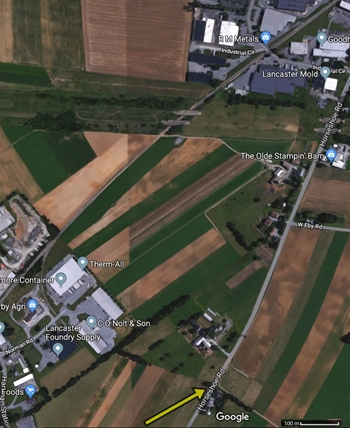
Satellite view showing area of Bushong farm.
Arrow points approximately to the second marker (post) on the west side of Johns acreage. An abandoned freeway right-of-way is visible towards the top.
Click to enlarge. Copyright © by Google all rights reserved.
|
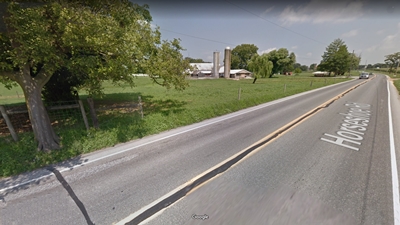
Street view where the Bushong farm was, looking north. The tree on the left is approximately where the warrantee's second west marker was. Click to enlarge. For Google Street View, click here From the street view, the address for the house to the east is 2400 Horseshoe Rd, Bird in Hand, Upper Leacock Township.Copyright © by Google all rights reserved.
|
|
Being able to see John Bushong's farm land offers a sense of closure for this ancestor of so many Bushong descendants. It also verifies the true motivation to come to America, which of course was land. Yes, John's protestant religion was clearly important to him. He was, after all, less than a mile from the church and was surrounded by Reformed and Quaker ministers and church benefactors. Still, it was not the driving reason he immigrated.
The family being dislocated Swiss Protestants, clearly would have made it difficult and more expensive to own land in Germany. So he came to America to get land he inherited from his father. For that, the Dutchman John Bushong brought his family on the dangerous voyage to the new wild country. For close to eighteen years he would live, work, and have two more children as an American. His grandchildren and their descendants would live their whole lives in America, thanks to John Bushong and his father, two Dutchmen on a quest for land in a country where they were free to follow their beliefs.
|
As mentioned, the first four children were born in Europe, and probably Germany. The last two were born in America.
- Mary Magdalena, his first born, married Johannes Paul Eckman (about 1708-1776) and had eight children. It is not known when she died but it was after 1763, when her son Daniel was born. Some suggest she died in Marshall, Indiana, but no sources are cited.
- First born son, Hans Philip married Anna Eva Hergard (1733-1778) and had nine children. As mentioned, Philip inherited the family farm and they lived in Lancaster County. But when he died in 1785, Philip's will was from Washington County, Maryland, close to Hagerstown, which is about 100 miles away from Bird in Hand.
- Daughter, Anna Barbara Bushong, married Philip Grim (1723-1793). They had nine children and lived in York County, Pennsylvania.
- Daughter Christianna was not noted after their immigration, and could have died, perhaps in the influenza pandemic of 1733-1734. There was no mention of her in John's will, or later estate papers. However, there is an A. Maria Bushung mentioned between 1767 and 1771 for Communion services in Earl County, Pennsylvania.68 It could be speculated that the "A' in her name is for Anna from Christianna. Then it is possible she was cut out of the will, since church records unfortunately list her as "eine Rahab" which is an old biblical word for prostitute. But realistically she should have been listed in the will even if she received nothing, so she probably had died.
- Son John was the first Bushong born in America and married Elizabeth Sprenkel (1732-1821). They had ten children in York County, before eventually moving to Shenandoah County, Virginia. John served as an officer in the American Revolutionary War, in two states, Pennsylvania and Virginia. He was known as a blacksmith, yet for a period owned a tavern. The view from his York County Tavern is the subject of a beautiful Colonial era engraving that was published in 1788.69 John died in Virginia in 1808.
- The last son was Jacob and he and his wife, Maria Juliana Weigel (1733-1810), are thought to have had twelve children (eleven mentioned in his will) the first nine, born in York County and the rest in Virginia. Jacob, like his brother, John was a blacksmith and served in the American Revolutionary War. He died in 1811, in Virginia.
All but one of the six children had children of their own, and between them they gave John 48 grandchildren. For named Bushong offspring alone, there are over 6000 known and charted descendants for John. These Bushongs and their descendants, who can call the Dutchman John Bushong, an ancestor, went on to form the largest branch in the Bushong Family Tree. Still it is just a part of the family tree.
References: John Bushong the Dutchman
- A Collection of Upwards of Thirty Thousand Names of German, Swiss, Dutch, French and Other Immigrants in Pennsylvania, 2nd Edition, by I. Daniel Rupp, Published 1875.
- Pennsylvania German Pioneers, Volume One, by Ralph Beaver Strassburger. Norristown, Pennsylvania, published 1934.
- Pennsylvania German Pioneers, Volume Two, by Ralph Beaver Strassburger. Norristown, Pennsylvania, published 1934.
- History of Lancaster County : to which is prefixed a brief sketch of the early history of Pennsylvania, by I. Daniel Rupp, Published 1844
- Leaves in the Wind, by Yolanda Beauchamp Presant, published 2017. Viewable here and here.
- John Beauchamp funerary record on FindaGrave here.
- Dispelling the Myth of Ellis Island Name Changes: viewable here.
- Why Immigrants Change Their Name, viewable here.
- The Origin and Meaning of the Bushong-Boschung Surname, by Rick Bushong, published 2012
- Pennsylvania Dutch and Other Essays, by Phebe Earle Gibbons, published 1872.
- 1870 Lancaster County, Pennsylvania. Phebe's listing is viewable here.
- Mary Wickes original source, viewable here.
- German Scripts Chart here Pops-up.
- Compare Hans' and Nicholas' signatures, here Pops-up
- Hans Bushong's October 16, 1734 Lancaster land survey.
- Hans Bushong's 1739 Naturalization Proclamation. To view complete proclamation (5 pages) click here here Pops-up
- DNA Connects Virtually All Bushongs To The Colonial Immigrants, by Rick Bushong, published: 2012
- Register for the church book of the Reformed parish Waldfischbach, 1684 - 1721, published 1988, by Dietmar Meyer.
- Register for the 2nd church book of the Reformed parish Waldfischbach, 1721 - 1755 (1757). published 1986, by Dietmar Meyer.
- Actual Church Records of Waldfischbach from FamilySearch.org.
- The Bushong United Family Tree, to search, click here.
- Compliments Dietmar Meyer, author, of the Reformed parish Waldfischbach Church Book transcriptions, email communications.
- Actual Church records: Oberwil, Simmental, Bern, Switzerland.
- International Genealogy Index (IGI), compliments of FamiySearch.org.
- Pink "John and William" and Captain Tymperton-The 1732 Immigrants Voyage, by Rick Bushong, published 2014.
- Copy of the actual 1731 Oath of Allegiance for the Britannia.
- Journey to Pennsylvania in the Year 1750 and Return to Germany in the Year 1754 by: Gottlieb Mittelberger, published 1756.
- Swiss Center of North America, viewable here.
- Library of Congress: The Germans in America, viewable here
- Our Swiss Family Bushong, Of the Simmental, Part Two:The Original Bushong in America, by Rick Bushong, published 2015.
- Salem Reformed Church at Heller's Near Leacock by Rev. Fred D. Pentz, Pastor, viewable here.
- Salem Evangelical Reformed Church, Hellers, viewable here.
- Upper Leacock Township-About Us, viewable here.
- The Local De - What the Germans brought to America, viewable here.
- Wikipedia the Krampus, viewable here.
- Wikipedia the Hamburger, viewable here.
- Wikipedia Gingerbread, viewable here.
- Lancaster Plain, c. 1730-1960, viewable here
- Sacred Texts, viewable here.
- Source not found.
- Lancaster History, The birth of Lancaster County, by H. Frank Eshleman, Esq, published 1908, viewable here.
- Taylors of Pa, by Sylvia, on RootsWeb, viewable (subject to change), here.
- History of Chester County, Pennsylvania, with Genealogical and Biographical Sketches,
by J. Smith Futhey, and Gilbert Cope, published 1881, viewable here.
- Copy of actual 1734 survey.
- New Jersey Monthly, Elizabeth Haddon, viewable here.
- Henry Wordsworth Longfellow, Tales of a Wayside Inn, published 1863. Read Longfellow's poem Elizabeth here.
- The Caldwallder Tree, viewable here.
- Quaker Arrivals at Philadelphia, 1682-1750, by Albert Cook Myers, published 1902 viewable here.
- Chester Pennsylvania Roots, viewable here.
- A collection of the epistles and works of B. Holme. Published 1753, viewable
here.
- History of Downingtown, Chester County, Pa, by Charles H. Pennypacker, published 1909, viewable here.
- Elizabeth Whartenby's funerary record on FindaGrave, viewable here.
- History of that part of the Susquehanna and Juniata Valleys, by E. Franklin and Austin N. Hungerford, published 1886 viewable here.
- LancasterHistory.org, viewable here.
- Warrantees of land in the several counties of the state of Pennsylvania, 1730-1898 (Vol. 24 page 355) viewable here.
- Benjamin Rush's Lectures on the Mind, published 1789, viewable here.
- The Immigrant Johann Nicholas Boschung-Germany to Pennsylvania, by Rick Bushong, published 2015.
- Lancaster County Pennsylvania Deed Book B, Pages 233-235, courtesy of Family History Library, Salt Lake City, Utah. Film/Fiche # 21382
- Pennsylvania Genealogical Magazine – Vol. 34.
- Connected survey map of Upper Leacock Township.
- Lancaster County Pennsylvania Deed Book P, 1 February 1764, Pages 519 - 521, courtesy of Family History Library, Salt Lake City, Utah, Film/Fiche # 21386.
- Pennsylvania Gazette, Published: November 23 1732, compliments of the National Archives.
- The Diffusion of Influenza: Patterns and Paradigms, by Gerald F. Pyle. Published 1986. Page 25,
- Journal of the Royal Society of Medicine, by: Eric L Altschulerc and Aesha Jobanputra, published 2014
- Connected survey map of Upper East Lampeter Township.
- Wikipedia Bird in Hand, viewable here.
- Wikipedia Pennsylvania Route 23, viewable here
- Sources & Documents of the Pennsylvania Germans: II, page 137: 19 Apr 1767. As printed in the Bushong Bulletin Volume 2, number 2, page 17, submitted by Judy Cassiday.
- The John Bushong Tavern Illustration on Bushong United, viewable here.
Bushong United is Copyright ©2019, 2023 by
Rick Bushong any Commercial Use is Prohibited.
Non-commercial use is allowed with permission or only if entire
copyright is included.
Photographs, unless otherwise noted are in the commons and are free use. No bandwidth theft allowed.
To Direct Search the Bushong United Family Tree click here
|
|






